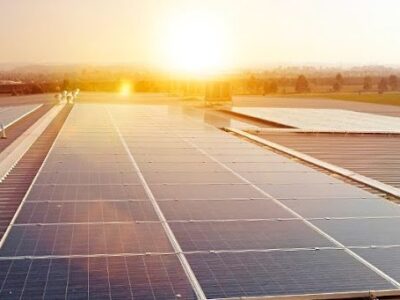From the moment the first oil well gave up that ole Texas tea nearly 160 years ago, the Lone Star State has seen its fair share of ups and downs in the market. Now, as oil prices continue their rapid descent, the state is adopting a new strategy, reducing its dependence on fossil fuels by embracing renewable energy sources like solar and wind power. It’s a “go big or go home” approach for Texas where more than a quarter of all corporate renewable energy deals worldwide were inked in 2019, according to Greentech Media. And the market is only getting bigger. Corporate renewable energy deals claimed 19.5 gigawatts of new contracts last year, a gain of 40 percent from the previous year. Texas alone accounted for 5.5 gigawatts of the 2019 total – more than Europe and Asia combined.
It’s like Texas was built for renewable energy. There’s land for days and you can’t stop the wind – especially in West Texas, where property is both cheap and plentiful. John Pappas, director of Texas A&M Engineering Experiment Station Clean Energy Incubator told us, “Wind power coexisting with O&G production may be a stabilizing influence on affected local economies —providing jobs and tax revenue.” He referenced ERCOT’s projections that wind power capacity in Texas will grow significantly year over year. “There will likely be an overall increase in wind lease payments to property owners as installed capacity increases. Wind is nowhere near as large an industry, but in places where the wind generation and O&G industries operate together, the jobs and tax revenue that wind power can provide are surely welcome.”
That would explain the rising demand from oil and gas producers for renewable energy. Two years ago ExxonMobil signed on for 500 megawatts of wind and solar power in West Texas’ Permian Basin. Occidental Petroleum and Energy Transfer Partners have both followed suit. Pappas says: “Compared to other sources powering the electrical grid, wind power has become price competitive and is now easier to manage on the grid than it was before. Wind is seen as a good investment and coexists with or complements investment in O&G and ranching. It also remains a growth investment.”
Corporate deals aren’t the only drivers in renewable energy’s increasingly attractive profile. A July announcement from Tesla CEO Elon Musk revealed that the next Cyberfactory would be built in Austin. The world’s largest electric vehicle manufacturer plans to use the factory to make its upcoming Cybertruck line, set for a 2021 release. Tesla chose Texas after being wooed by a coterie of big names, including Governor Greg Abbot and Senator Ted Cruz. The Palo Alto-based company also got tens of millions of dollars in tax breaks from local government bodies.
Tesla’s news followed the June announcement that Greentown Labs, North America’s largest incubator of climate tech startups, will open a second location in Houston. Dubbed Greentown Houston, the facility is expected to open in spring 2021 and will include more than 40,000 square feet of prototyping lab and office space for 50 plus startups. It will be Houston’s first climate tech startup incubator. In the announcement, CEO Emily Reichert said: “We believe the engineering strength, talent, and assets of the energy industry in Houston can and must be redeployed toward a decarbonized future. Climate change cannot be solved from the coasts — we need all hands on deck at this time.”
It’s a good time for Greentown to enter the Texas scene. Pappas said, “Investor interest in our renewable energy-related startups has increased over time. Some potential investors are looking for technologies that represent a next step that opens new submarkets, others are looking for an entry point to the entire industry. In some cases that interest is partially driven in the macro sense by a belief from some investors that our energy portfolio needs to continue to diversify.” Greentown Houston has a large roster of founding partners, including oil and gas giants Chevron, Royal Dutch Shell, and BHP Group. This continues a trend that has seen more big oil companies embrace low-carbon energy technology.
Low-carbon energy includes more than just wind. The sun shines steady in Texas, in fact, 80 percent of 2019’s corporate deals signed in the state were for solar energy. One of them involved College Station-based Texas Green Energy, which provides solar energy systems to the commercial, utility, and residential markets, including hotels, retail centers, warehouses, government buildings, parks, and campgrounds. Their reach extends beyond the Lone Star State, all the way to Walla Walla, Washington where they installed a solar energy system for a Holiday Inn Express. Back home, they’re tackling large local projects like a rebuild of the Alamo 2, a 4.4-megawatt solar farm in San Antonio.
All of this activity comes during a year of considerable challenges for the fossil fuel and renewable energy industries. A reduction in both transportation and travel during COVID-19 has contributed to a 27 percent decline in crude oil prices in 2020. An World Economic Forum article noted that global energy demand dropped to levels “not seen in 70 years.” Oil demand is expected to fall 9 percent and coal 8 percent for the year. Challenges can become opportunities and the decrease in demand for oil is stimulating demand for renewable sources. The World Economic Forum noted that in less than 10 weeks, the U.S. increased its renewable energy consumption by nearly 40 percent.
Even so, the renewable energy industry has run into its own coronavirus-related headwinds. The Union of Concerned Scientists is calling for tax credits to build clean energy facilities and manufacture clean energy products, as well as loan guarantees for clean energy projects to stimulate the jobs recovery. Over 600,000 clean energy workers filed for unemployment March – May and more job losses are expected as many solar and wind industry projects are put on hold. But the biggest consumer of electricity in the country is gonna find a way to keep the lights on. My money’s on Texas. It’s energy HQ.
Check out the episode of the Consensus in Conversation podcast featuring Juliana Garaziar of Greentown Labs.





